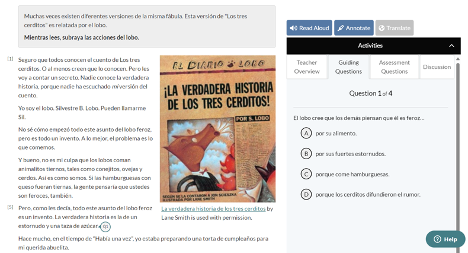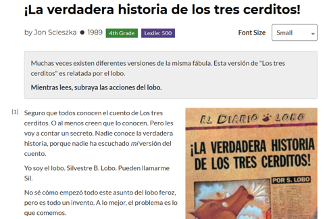
Engaging Students with Readings from CommonLit
By Jenna Bacchi, Southern Oregon University

DOI: https://www.doi.org/10.69732/JQZU9982
Introduction
Finding quality readings for my classroom is a consistent challenge. This is a difficult task because level-appropriate materials are not always readily available. To look for solutions, I recently tried out CommonLit’s stash of articles. CommonLit offers a library of free readings to use in your language classroom for English and Spanish learners. In this article, I will explain what CommonLit is, how it works, how I used it, and offer some suggestions for language teaching with CommonLit.
| Program | CommonLit |
| URL | commonlit.org |
| Purpose | Grade level readings in English and Spanish |
| Cost | Free version
Administrator packages: School Essentials: $2,500 School Essentials Pro: $3,800 School Essentials Pro Plus: $6,500 |
| Ease of Use | Simple and easy to find various readings for levels 3 to 12 |

Overview of CommonLit
The readings in CommonLit include assessments that accompany them. Additionally, the site offers CommonLit360 unit plans that are available for teachers to access. You can filter out choices so that the search results are limited to the grade level, genre, language (English or Spanish), literature reading standards, and content type that you specify. If you have a solid curriculum that you already use in your classroom, you really can be very well supplemented with the free version. However, there are much larger packages available too, which range from $2,500 to $6,000 with resources / curriculum for 3 to 4 years which include aspects such as an account manager, ClassLink and Clever rostering integrations, priority user support, and full Canvas LMS integration (CommonLit also integrates with ClassLink, Clever, or Google Classroom). You can find more information about what features are available for each account type at the company’s pricing page.
In the free version, which is what I assessed, there are many Spanish options available from 3rd to 12th grade reading levels, with even more choices available for teaching English. Overall, from these readings you can expect to offer your students a solid text with comprehension questions in the form of multiple choice and short written answers. Throughout the reading you will find some less common words accompanied by a definition in Spanish if you click on the number button next to it. This is where I saw support for the student’s comprehension of the language.

Drawbacks of the Tool and Advice for Integration into Your Classroom
The free version of CommonLit does not include grammar activities, and each article includes only one or two images. There are no national or regional variations of English or Spanish offered. Additionally, there is not very much feedback to the student when answering questions, just if the answer is right or wrong. If students answer the question wrong, they get another opportunity. The students do not receive awards or badges for their achievements, and the program is not designed for students to interact with each other while using the website. However, it would be rather simple to create activities on your own. My suggestion would be to create your own visuals to go over vocabulary and grammar that you know students are not familiar with prior to engaging with the reading. After ensuring that the students have a strong understanding of the new vocabulary and any grammar structures that they will see, I would also suggest going through the reading with students. You can create more clarity and ask questions to the students to gauge their understanding, and you can incorporate games, drawings, or any other interactive activity with the reading. From there, you could have the students do the reading in pairs, groups, or on their own and discuss and answer the questions. If you feel it is necessary, you can go over the answers from the questions provided in the text with the students to make it more interactive and encourage stronger comprehension.

Teaching with CommonLit
I used the Spanish options from CommonLit in my classes as extra reading material, in addition to the books on my shelf, and I have also used it as a supplement. Recently, I used the tool with the feature that allows you to create a classroom where you can organize your students into the appropriate classrooms and link their school Google email accounts. Additionally, you can have their scores automatically uploaded into their Google accounts when you do create your classrooms. The students had no issues creating an account quickly and finding the assignment. I used this with my Spanish 3 and 4 classes, and it was very intuitive to create the class in CommonLit and connect it to Google Classroom. In one assignment in my Spanish 4 class, we used El Día que llegó el Pan a México (The Day that Bread Arrived in Mexico). This reading was a little more challenging for my students, so I read the passage with them to provide extra scaffolding in the form of putting vocabulary words into terms that they understand. Additionally, reading with my students helped me keep them more engaged by pulling them in with questions and clarifying the meanings of words. I used an article about Mexico because I know some of the students are learning about Mexico as well in their World Geography class. After each passage in the reading included in the CommonLit program, the students were prompted to respond to a question to gauge their understanding. I really enjoy this feature because it gives me formative feedback about their comprehension, and they are receiving immediate feedback as well. There were writing sections included that allowed me to gauge their understanding and writing skills on my own time. I liked how easy it was to grade their assignments, as well as the fact that the app automatically grades multiple choice questions.
Some of the student feedback was that that reading did not capture their attention, and that it was too difficult.
On another day I had each class, Spanish 3 and 4, do a different story on their own; this story was about a topic we had already covered in class, The Three Little Pigs. CommonLit offers a follow up story called ¡La Verdadera Historia de los Tres Cerditos! (The True Story of the Three Little Pigs).

Each student was tasked to complete that assignment alone on their own computers with their school Google email accounts, which is what they use to log into the commonLit website, and connect to the class I created for them. They all read the stories quietly and responded to the answers. Afterwards, they responded to some questions I had about their experience with that activity. Since this activity was about a more animated topic and related to a lesson we had done before, my students were more positive about their experiences. I received feedback that they thought it was a great tool for the classroom, they liked that this story was related to another unit we had done, and that it helped that they were familiar with the concept. Many students also felt that it was something different and worked well, that it was a challenge but doable, and every single student responded that they liked the story. However, there were some students who simply did not like doing the assignment, felt it was a little overwhelming, and that there were many vocabulary words they did not know.
One of the challenges I see with this website is finding readings that are appropriate for the students’ level. When the students are properly prepared with a lesson that addresses vocabulary and grammar concepts that they will see in the text, prior to reading the text, the students are capable of reading at the levels that correspond with the reading level of the text. The students will see more success when the teacher creates a unit or lessons that lead up to reading the text. However, when grabbing a reading off the website without preparatory lessons to aid in their understanding, it is not as accessible to them at any level. Still, I find CommonLit to be a fantastic resource, but see it being more useful when built into a unit with more scaffolding and preparation for L2 learners.
Conclusion and Overall Recommendations
In conclusion, CommonLit can be a useful part of an overall solid curriculum, with these recommendations in mind:
- Find an article that the students can relate to, or will show interest in.
- Look through the text and identify vocabulary and grammar concepts that the students need to hone in on.
- Build a unit plan that will address the phrases, vocabulary, and content that will be presented to them through the text.
- Give the students the reading after the lesson that builds up to the reading. Read it with them to bring in greater understanding of the reading, if you feel that it’s necessary.
- Ask the students to read it alone or in pairs and answer comprehension questions.

Excellent overview of the CommonLit website and its offerings, as well as the suggestions for integrating them into classwork. I’m going to look into it further and see how I can use these resources in my own classes!
Thank you very much!
– Edo Forsythe